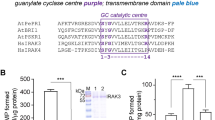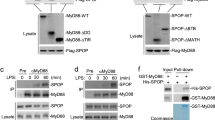Abstract
Members of the IRAK family of kinases mediate Toll-like receptor (TLR) signaling. Here we show that IRAK2 was essential for sustaining TLR-induced expression of genes encoding cytokines and activation of the transcription factor NF-κB, despite the fact that IRAK2 was dispensable for activation of the initial signaling cascades. IRAK2 was activated 'downstream' of IRAK4, like IRAK1, and TLR-induced cytokine production was abrogated in the absence of both IRAK1 and IRAK2. Whereas the kinase activity of IRAK1 decreased within 1 h of TLR2 stimulation, coincident with IRAK1 degradation, the kinase activity of IRAK2 was sustained and peaked at 8 h after stimulation. Thus, IRAK2 is critical in late-phase TLR responses, and IRAK1 and IRAK2 are essential for the initial responses to TLR stimulation.
This is a preview of subscription content, access via your institution
Access options
Subscribe to this journal
Receive 12 print issues and online access
$209.00 per year
only $17.42 per issue
Buy this article
- Purchase on Springer Link
- Instant access to full article PDF
Prices may be subject to local taxes which are calculated during checkout








Similar content being viewed by others
References
Akira, S., Uematsu, S. & Takeuchi, O. Pathogen recognition and innate immunity. Cell 124, 783–801 (2006).
Janeway, C.A., Jr. & Medzhitov, R. Innate immune recognition. Annu. Rev. Immunol. 20, 197–216 (2002).
Beutler, B. Inferences, questions and possibilities in Toll-like receptor signalling. Nature 430, 257–263 (2004).
Adachi, O. et al. Targeted disruption of the MyD88 gene results in loss of IL-1- and IL-18-mediated function. Immunity 9, 143–150 (1998).
Kawai, T., Adachi, O., Ogawa, T., Takeda, K. & Akira, S. Unresponsiveness of MyD88-deficient mice to endotoxin. Immunity 11, 115–122 (1999).
Fitzgerald, K.A. et al. Mal (MyD88-adapter-like) is required for Toll-like receptor-4 signal transduction. Nature 413, 78–83 (2001).
Horng, T., Barton, G.M. & Medzhitov, R. TIRAP: an adapter molecule in the Toll signaling pathway. Nat. Immunol. 2, 835–841 (2001).
Horng, T., Barton, G.M., Flavell, R.A. & Medzhitov, R. The adaptor molecule TIRAP provides signalling specificity for Toll-like receptors. Nature 420, 329–333 (2002).
Yamamoto, M. et al. Essential role for TIRAP in activation of the signalling cascade shared by TLR2 and TLR4. Nature 420, 324–329 (2002).
Hoebe, K. et al. Identification of Lps2 as a key transducer of MyD88-independent TIR signalling. Nature 424, 743–748 (2003).
Oshiumi, H., Matsumoto, M., Funami, K., Akazawa, T. & Seya, T. TICAM-1, an adaptor molecule that participates in Toll-like receptor 3-mediated interferon-β induction. Nat. Immunol. 4, 161–167 (2003).
Yamamoto, M. et al. Role of adaptor TRIF in the MyD88-independent toll-like receptor signaling pathway. Science 301, 640–643 (2003).
Kagan, J.C. et al. TRAM couples endocytosis of Toll-like receptor 4 to the induction of interferon-β. Nat. Immunol. 9, 361–368 (2008).
Fitzgerald, K.A. et al. LPS-TLR4 signaling to IRF-3/7 and NF-κB involves the toll adapters TRAM and TRIF. J. Exp. Med. 198, 1043–1055 (2003).
Yamamoto, M. et al. TRAM is specifically involved in the Toll-like receptor 4–mediated MyD88-independent signaling pathway. Nat. Immunol. 4, 1144–1150 (2003).
Janssens, S. & Beyaert, R. Functional diversity and regulation of different interleukin-1 receptor-associated kinase (IRAK) family members. Mol. Cell 11, 293–302 (2003).
Suzuki, N. et al. Severe impairment of interleukin-1 and Toll-like receptor signalling in mice lacking IRAK-4. Nature 416, 750–756 (2002).
Suzuki, N. et al. IL-1R-associated kinase 4 is required for lipopolysaccharide-induced activation of APC. J. Immunol. 171, 6065–6071 (2003).
Honda, K. et al. Role of a transductional-transcriptional processor complex involving MyD88 and IRF-7 in Toll-like receptor signaling. Proc. Natl. Acad. Sci. USA 101, 15416–15421 (2004).
Koziczak-Holbro, M. et al. IRAK-4 kinase activity is required for interleukin-1 (IL-1) receptor- and toll-like receptor 7-mediated signaling and gene expression. J. Biol. Chem. 282, 13552–13560 (2007).
Kim, T.W. et al. A critical role for IRAK4 kinase activity in Toll-like receptor-mediated innate immunity. J. Exp. Med. 204, 1025–1036 (2007).
Kawagoe, T. et al. Essential role of IRAK-4 protein and its kinase activity in Toll-like receptor-mediated immune responses but not in TCR signaling. J. Exp. Med. 204, 1013–1024 (2007).
Picard, C. et al. Pyogenic bacterial infections in humans with IRAK-4 deficiency. Science 299, 2076–2079 (2003).
Medvedev, A.E. et al. Cutting edge: expression of IL-1 receptor-associated kinase-4 (IRAK-4) proteins with mutations identified in a patient with recurrent bacterial infections alters normal IRAK-4 interaction with components of the IL-1 receptor complex. J. Immunol. 174, 6587–6591 (2005).
Yang, K. et al. Human TLR-7-, -8-, and -9-mediated induction of IFN-α/β and -λ is IRAK-4 dependent and redundant for protective immunity to viruses. Immunity 23, 465–478 (2005).
Ku, C.L. et al. Selective predisposition to bacterial infections in IRAK-4-deficient children: IRAK-4-dependent TLRs are otherwise redundant in protective immunity. J. Exp. Med. 204, 2407–2422 (2007).
Kobayashi, K. et al. IRAK-M is a negative regulator of Toll-like receptor signaling. Cell 110, 191–202 (2002).
Croston, G.E., Cao, Z. & Goeddel, D.V. NF-κB activation by interleukin-1 (IL-1) requires an IL-1 receptor-associated protein kinase activity. J. Biol. Chem. 270, 16514–16517 (1995).
Kanakaraj, P. et al. Interleukin (IL)-1 receptor-associated kinase (IRAK) requirement for optimal induction of multiple IL-1 signaling pathways and IL-6 production. J. Exp. Med. 187, 2073–2079 (1998).
Thomas, J.A. et al. Impaired cytokine signaling in mice lacking the IL-1 receptor-associated kinase. J. Immunol. 163, 978–984 (1999).
Uematsu, S. et al. Interleukin-1 receptor-associated kinase-1 plays an essential role for Toll-like receptor (TLR)7- and TLR9-mediated interferon-α induction. J. Exp. Med. 201, 915–923 (2005).
Muzio, M., Ni, J., Feng, P. & Dixit, V.M. IRAK (Pelle) family member IRAK-2 and MyD88 as proximal mediators of IL-1 signaling. Science 278, 1612–1615 (1997).
Hardy, M.P. & O'Neill, L.A. The murine IRAK2 gene encodes four alternatively spliced isoforms, two of which are inhibitory. J. Biol. Chem. 279, 27699–27708 (2004).
Keating, S.E., Maloney, G.M., Moran, E.M. & Bowie, A.G. IRAK-2 participates in multiple toll-like receptor signaling pathways to NFκB via activation of TRAF6 ubiquitination. J. Biol. Chem. 282, 33435–33443 (2007).
Wesche, H. et al. IRAK-M is a novel member of the Pelle/interleukin-1 receptor-associated kinase (IRAK) family. J. Biol. Chem. 274, 19403–19410 (1999).
Yamin, T.T. & Miller, D.K. The interleukin-1 receptor-associated kinase is degraded by proteasomes following its phosphorylation. J. Biol. Chem. 272, 21540–21547 (1997).
Li, X. et al. Mutant cells that do not respond to interleukin-1 (IL-1) reveal a novel role for IL-1 receptor-associated kinase. Mol. Cell. Biol. 19, 4643–4652 (1999).
Swantek, J.L., Tsen, M.F., Cobb, M.H. & Thomas, J.A. IL-1 receptor-associated kinase modulates host responsiveness to endotoxin. J. Immunol. 164, 4301–4306 (2000).
Li, S., Strelow, A., Fontana, E.J. & Wesche, H. IRAK-4: a novel member of the IRAK family with the properties of an IRAK-kinase. Proc. Natl. Acad. Sci. USA 99, 5567–5572 (2002).
Knop, J. & Martin, M.U. Effects of IL-1 receptor-associated kinase (IRAK) expression on IL-1 signaling are independent of its kinase activity. FEBS Lett. 448, 81–85 (1999).
Maschera, B., Ray, K., Burns, K. & Volpe, F. Overexpression of an enzymically inactive interleukin-1-receptor-associated kinase activates nuclear factor-κB. Biochem. J. 339, 227–231 (1999).
Li, X., Commane, M., Jiang, Z. & Stark, G.R. IL-1-induced NFκB and c-Jun N-terminal kinase (JNK) activation diverge at IL-1 receptor-associated kinase (IRAK). Proc. Natl. Acad. Sci. USA 98, 4461–4465 (2001).
Jensen, L.E. & Whitehead, A.S. IRAK1b, a novel alternative splice variant of interleukin-1 receptor-associated kinase (IRAK), mediates interleukin-1 signaling and has prolonged stability. J. Biol. Chem. 276, 29037–29044 (2001).
Rechsteiner, M. & Rogers, S.W. PEST sequences and regulation by proteolysis. Trends Biochem. Sci. 21, 267–271 (1996).
Takeuchi, O. et al. Cutting edge: preferentially the R-stereoisomer of the mycoplasmal lipopeptide macrophage-activating lipopeptide-2 activates immune cells through a toll-like receptor 2- and MyD88-dependent signaling pathway. J. Immunol. 164, 554–557 (2000).
Hemmi, H. et al. Toll-like receptor recognizes bacterial DNA. Nature 408, 740–745 (2000).
Sato, S. et al. A variety of microbial components induce tolerance to lipopolysaccharide by differentially affecting MyD88-dependent and -independent pathways. Int. Immunol. 14, 783–791 (2002).
Barton, G.M., Kagan, J.C. & Medzhitov, R. Intracellular localization of Toll-like receptor 9 prevents recognition of self DNA but facilitates access to viral DNA. Nat. Immunol. 7, 49–56 (2006).
Acknowledgements
We thank J.A. Thomas (University of Texas Southern Medical Center) for Irak1–/– mice; all our colleagues in our laboratory; M. Hashimoto for secretarial assistance; and Y. Fujiwara, M. Shiokawa, A. Shibano and N. Kitagaki for technical assistance. Supported by the Ministry of Education, Culture, Sports, Science, and Technology of Japan; the Ministry of Health, Labour and Welfare of Japan; the 21st Century Center of Excellence Program of Japan; and the National Institutes of Health (AI070167).
Author information
Authors and Affiliations
Contributions
T. Kawagoe, O.T. and S.A. designed the research and analyzed data; T. Kawagoe did most of the experiments; S.S., K. Matsushita., H.K., K. Matsui., Y.K., T.S. and T.K. provided advice; and T. Kawagoe, O.T. and S.A. prepared the manuscript.
Corresponding author
Supplementary information
Supplementary Text and Figures
Supplementary Figures 1–5 (PDF 3925 kb)
Supplementary Table 1
Gene lists and expression profiles of MALP-2-inducible genes in wild-type, Irak2–/– and Irak1–/YIrak2–/– macrophages (XLS 79 kb)
Rights and permissions
About this article
Cite this article
Kawagoe, T., Sato, S., Matsushita, K. et al. Sequential control of Toll-like receptor–dependent responses by IRAK1 and IRAK2. Nat Immunol 9, 684–691 (2008). https://doi.org/10.1038/ni.1606
Received:
Accepted:
Published:
Issue Date:
DOI: https://doi.org/10.1038/ni.1606
This article is cited by
-
The protease calpain2a limits innate immunity by targeting TRAF6 in teleost fish
Communications Biology (2023)
-
Emerging trends in IRAK-4 kinase research
Molecular Biology Reports (2023)
-
IRAK2-NF-κB signaling promotes glycolysis-dependent tumor growth in pancreatic cancer
Cellular Oncology (2022)
-
Protein phosphatases in TLR signaling
Cell Communication and Signaling (2021)
-
Kinase inhibition in autoimmunity and inflammation
Nature Reviews Drug Discovery (2021)



